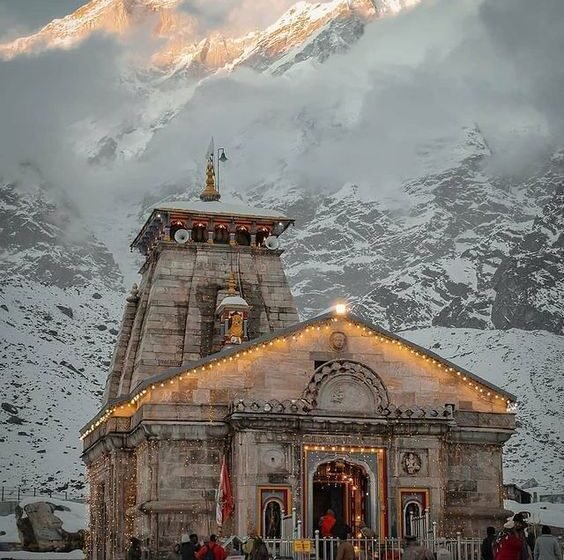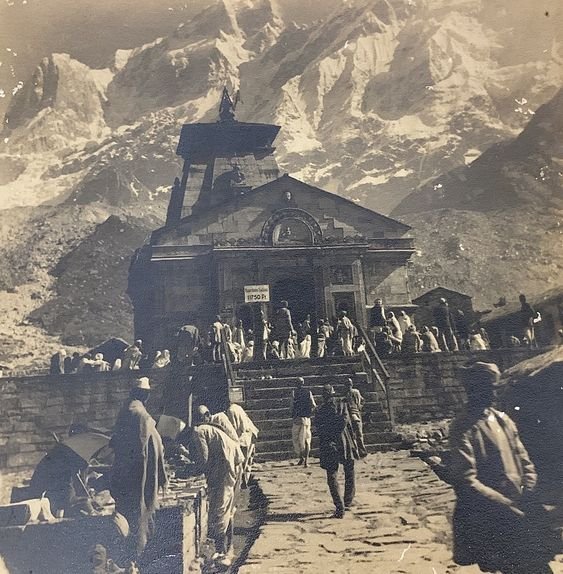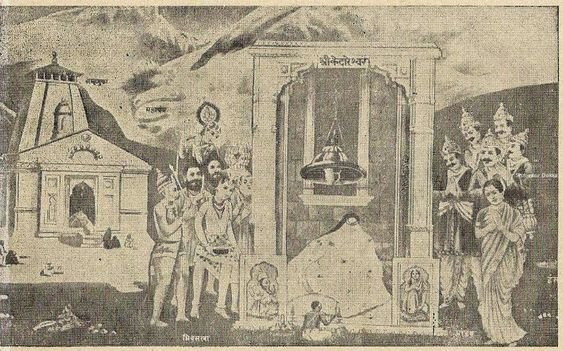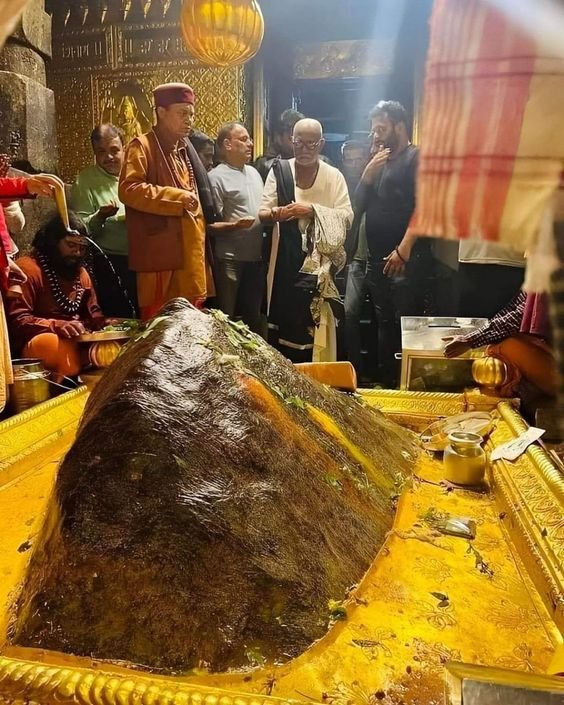Kedarnath Jyotirlinga: A Pilgrimage to the Heart of the Himalayas
- Indian Mythology Ancient history Asian history mythology
 Kanishka Dwivedi
Kanishka Dwivedi- July 15, 2024
- 0
- 332

If there is one Jyotirlingam that every young Indian definitely wants to travel to, it is the Kedarnath Jyotirlingam. The picturesque snow- covered mountain, the thrilling trek, the lakes, gorges, and in the end, the darshan of the divine marks a complete spiritual adventure. There are places you wish to travel solo, there are places like Goa, where a company of friends only is wished for, but I believe, Kedarnath is the one place where we all can travel to in any manner, be it solo or with family or with friends, without any as such priority. All that matters is “Kedarnath”.

Perched at an elevation of 3500 meters amidst the immaculate white backdrop of the Garhwal Himalayas, the Kedarnath temple is a veritable wonder in and of itself. There isn’t much recorded history of the Kedarnath Temple because it is so old. Historians and philosophers of Hinduism assert that the temple is over three millennia old. There are those who assert that the temple was constructed in the eighth century by the renowned Hindu philosopher and saint Adi Shankaracharya.
On the other hand, it is thought that the current temple is located close to the location of an old Shiva temple that the Pandavas (of the Mahabharata) constructed some 6000 years ago. Some hagiographies state that at the age of thirty-two, Adi Shankaracharya went to the temple to seek salvation (Maha Samadhi).

Kedarnath is first mentioned in the Skanda Purana (7th–8th century) in a narrative that describes the Ganga River’s creation. According to the Purana, Lord Shiva let the Ganga’s sacred stream escape his matted hair at Kedarnath. Since Kedarnath is situated in an inaccessible area, it has not sustained significant damage from humans over time. Some of the components that greatly enhance Kedarnath’s allure are miracle stories and legends from the Mahabharata era.
Following the conclusion of the Mahabharata war, the five Pandava brothers harboured regrets over the deaths of their close relatives by their own hands. In order to atone for their sins, they made the decision to travel to Kailash in the Himalayas and seek Lord Shiva’s blessings. However, Lord Shiva didn’t want to give them a sudden pleasure of becoming free from this horrendous act hence he fled the Pandavas by disguising himself as a bull.
The Pandavas saw a strange-looking bull when they arrived at Gaurikund in the Himalayas after continuing their search for Lord Shiva. Bheema fought the bull with his mace.
Shiva descended into the earth, and upon his resurrection, various body parts appeared in various locations. The bull’s two forelegs are Tunganath, which is on the way to Kedar, and the bull’s hump is Kedarnath. The navel appeared in Madhya-Maheshwar which is an extremely powerful Manipuraka Linga located in the Indian portion of the Himalayas. Lord Shiva’s matted locks appeared in Kalpnath. In this way, various body parts showed up in various locations. Together, these are known as Panch Kedar.

The Pandavas asked Lord Shiva for his blessing after realizing who he was, and he pardoned their transgressions. After that, the Pandavas constructed Kedarnath’s first temple, and Lord Shiva lived in it as a Jyotirlinga.
Kedarnath temple is one of the 275 Padal Petra Sthalams, or the most potent Shiva temples worldwide for Shaiva Nayanars, which has great religious significance for Hindu devotees. They hold that you can become free of all earthly sins by offering selfless, devoted prayers to Lord Kedareshwara. You will eventually reach Moksha and enter Swarga after death by darshan of the lord.
Great Hindu saints like Adi Sankaracharya and Tamil Nayanar saints from the sixth century both held the temple in high regard. Within the complex of temples is a holy quadrangle known as the Brahma Kunda. It is thought that taking a sip of its water will protect its followers from unintentional death.
There is a story that once Adi Shankaracharya was entering a temple in Kashi after taking a bath. On his way, he encountered a Chandala, lowest caste persons who maintained cremation grounds. Shankara asked him to move out of his way as popular belief was that death is certain if you encounter a chandala on your way. To this request, the Chandala argued with Shankara, “who should move, my body or my soul?” This stumped Shankara because all his life he was the one teaching that “This body is not you, this is maya”. Affected by this, he travelled to Himalayas near Kedarnath and it is believed that Kedarnath is where Adi Shankarachaya was last seen. The story goes that he walked up and merged into Shiva. In India, it is believed that we don’t rise our way by elbowing up, we rise by bowing down. Hence, recently, to pay respects to the great saint, the Government has also established a monument of Adi Shankaracharya in Kedarnath.

Numerous archaeologists and researchers are still inspired by the remarkable fusion of science and spirituality that resulted in the construction of the Kedarnath temple. The temple’s strong foundation and skillful architecture have allowed it to withstand nature’s fury time and time again, despite being located in a disaster-prone area. Massive grey stone slabs that are evenly cut and heavy make up the structure of Kedarnath Temple. Parvathi and the five Pandava princes are depicted in exquisite detail in a pillared hall in front of the temple complex. Within the hall, there are also pictures of Lord Krishna and other Hindu deities. A statue of Nandi Maharaj, a sacred bull who is revered as Shiva’s vehicle, stands guard outside the temple entrance as you approach it. All of the rituals are performed in the Garbh Griha, or sanctum sanctorum, of the temple. Additionally, there is a sizable Mandap (assembly hall) that is embellished with idols representing a variety of gods and scenes from Hindu mythology. The pilgrims and guests assemble around this mandap. The temple’s Shivalingam is highest among the 12 Jyotirlingams as it is 12 feet tall and 12 feet in circumference. Researchers are still unsure of what makes the temple architecture so earthquake-resistant, which piques people’s interest in this location.

Over the years, the Kedarnath temple has experienced its fair share of mysteries and miracles that remain unsolved. Many people think that Shiva is constantly present at Kedarnath and guards the temple from all harm. This was demonstrated in 2013 during the catastrophic flash floods that destroyed the entire town around the temple. But surprisingly, there was no harm done to the Kedarnath temple during this disaster.
Waters tumbling down the mountains caused a massive rock to mysteriously wedge itself between the temple and the debris. The temple was spared the calamity when the boulder diverted the flow of water and debris to its sides. This boulder, which is currently worshipped as Bheem-shila, is still visible behind the temple.

The temple is open only for 6 months in a year. It closes in October-November and reopens again in April-May when the Sun enters Aries. In addition to daily rituals and Pujanas, Kedarnath celebrates a number of festivals, such as the Shravan Annakoot Mela (fair) in August and the Samadhi Pooja on the final day of the temple. The most well-known of all is the eight-day Badri-Kedar festival, which takes place in June. The festival showcases the rich Indian culture and brings together talented artists from across the nation.
So now that you know everything about the temple and its history, your trip to Kedarnath will be more spiritual, fulfilling and joyous and surreal.


